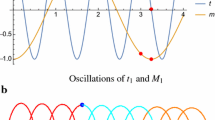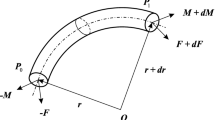Abstract
We present a general approach to the bifurcation analysis of spatial framework structures with symmetry. While group-theoretic methods for bifurcation problems with symmetry are well known, their actual implementation in the context of geometrically exact frameworks is not straightforward. We consider spatial structures comprising assemblages of Cosserat rods; the main difficulty arises from the nonlinear configuration space, due to the presence of (cross-sectional) rotation fields. We avoid this via a single-rod formulation, developed earlier by one of the authors, whereby the governing equations are embedded in a slightly enlarged linear space. The field equations for a framework then comprise the assembly of all such rod equations, supplemented by compatibility and equilibrium conditions at the joints. We demonstrate their equivariance under the natural symmetry group action, and the implementation of group-theoretic methods is now clear within the enlarged linear space. All potential generic, symmetry-breaking bifurcations are predicted a-priori. We then employ an open-source path-following code, which can detect and compute simple, one-dimensional bifurcations; multiple bifurcation points are beyond its capabilities. For the latter, we construct symmetry-reduced problems implemented by appropriate substructures. Multiple bifurcations are rendered simple, and the path-following code is again applicable. We first analyze a simple tripod framework, providing all details of our methodology. We then treat a more complex hexagonal space frame via the same approach. Both structures exhibit simple and double bifurcation points.
















Similar content being viewed by others
Data Availability
The datasets generated during and/or analyzed during the current study are available from the corresponding author on reasonable request.
References
A. Bossavit, Symmetry, groups, and boundary value problems. a progressive introduction to noncommutative harmonic analysis of partial differential equations in domains with geometrical symmetry,” Comput. Meth. Appl. Mech. Engrg., vol. 56, no. 2, pp. 167–215, 1986.
A. Vanderbauwhede, Local bifurcation and symmetry, Pitman, 1980.
Combescure, C., Elliott, R.S., Triantafyllidis, N.: Deformation patterns and their stability in finitely strained circular cell honeycombs. J. Mech. Phys. Solids 142, 103976 (2020)
Combescure, C., Henry, P., Elliott, R.S.: Post-bifurcation and stability of a finitely strained hexagonal honeycomb subjected to equi-biaxial in-plane loading. Int. J. Solids Struct. 88–89, 296–318 (2016)
D. Sattinger, Group theoretic methods in bifurcation theory, Springer-Verlag, 1979.
Dellnitz, M., Werner, B.: Computational methods for bifurcation problems with symmetries - with special attention to steady state and Hopf bifurcation points. J. Comput. Appl. Math. 26, 97–123 (1989)
E. Doedel, R.C. Paffenroth, A.R. Champneys, T.F. Fairgrieve, Y.A. Kuznetsov, B.E. Oldeman, B. Sandstede, X. Wang, AUTO-07P: Continuation and bifurcation software for ordinary differential equations (2007) http://indy.cs.concordia.ca/auto/.
Elliott, R.S., Triantafyllidis, N., Shaw, J.A.: Reversible stress-induced martensitic phase transformations in a bi-atomic crystal. J. Mech. Phys. Solids 59, 216–236 (2011)
H. Kielhöfer, Bifurcation theory, 2nd Ed., Springer, 2012
Healey, T.J.: A group-theoretic approach to bifurcation problems with symmetry. Comput. Meth. Appl. Mech. Engrg. 67, 257–295 (1988a)
Healey, T.J.: Global bifurcation and continuation in the presence of symmetry with an application to solid mechanics. SIAM J. Math Anal. 19, 824–840 (1988b)
Healey, T.J.: Material symmetry and chirality in nonlinearly elastic rods. Math. Mech. Solids 7, 405–420 (2002)
Healey, T.J., Mehta, P.G.: Straightforward computation of spatial equilibria of geometrically exact Cosserat rods. Int. J. Bifurcation Chaos 15, 949–965 (2005)
Ikeda, K., Murota, K.: Bifurcation analysis of symmetric structures using block-diagonalization. Comput. Methods Appl. Mech. Engrg. 86, 215–243 (1991)
J. Glowacki, Computation and visualization in multiscale modelling of DNA mechanics, doctoral dissertation, Chaire D’Analyse Appliquée, Ecole Polytechnique Federale de Lausanne, Suisse, 2016.
K. Ikeda, K. Murota, Imperfect bifurcation in structures and materials, Springer, 2010
M. Golubitsky, I. Stewart, D.G. Schaeffer, Singularities and groups in bifurcation theory, Vol. II, Springer-Verlag, 1988.
P. Chossat, R. Lauterbach, Methods in Equivariant Bifurcations and Dynamical Systems, World Scientific, 2000.
R. McWeeny, An introduction to group theory and its applications, Dover Publications, 2002
S.J. Mohand, Group theoretic framework for fem analysis of symmetric structures, doctoral dissertation, department of mechanical engineering, indian institute of science, Bangalore, India, 2004
S.J. Britvec, The Stability of Elastic Systems, Pergamom Press, 1973.
Simo, J.C., Vu-Cuoc, L.: A three-dimensional finite-strain rod model Part II: computational aspects. Comput. Methods Appl. Mech. Engrg. 58, 79–116 (1986)
Wohlever, J.C., Healey, T.J.: A group-theoretic approach to global bifurcation analysis of an axially compressed cylindrical shell. Comput. Methods Appl. Mech. Engrg. 122, 315–349 (1995)
Yu, T., Deier, L., Marmo, F., Gabriele, S., Parascho, S., Adriaenssens, S.: Numerical modeling of static equilibria and bifurcations in bigons and bigon rings. J. Mech. Phys. Solids 152, 104459 (2021)
Zingoni, A.: Group-theoretic exploitations of symmetry in computational solid and structural mechanics. Int. J. Numer. Meth. Engng. 79, 253–289 (2009)
Acknowledgements
The work of TJH was supported in part by the National Science Foundation through grant DMS-2006586, which is gratefully acknowledged. CJC acknowledges support from Project ISITE FUTURE MAJOR, University Paris-Est Marne-la-Vallée.
Author information
Authors and Affiliations
Contributions
CJC, JT, and TJH participated in developing the theoretical methods. CJC carried out the numerical computations, and TJH wrote the main manuscript text. All authors reviewed the manuscript.
Corresponding author
Ethics declarations
Conflict of interest
All authors declare that they have no conflicts of interest to disclose.
Additional information
Communicated by Eliot Fried.
Publisher's Note
Springer Nature remains neutral with regard to jurisdictional claims in published maps and institutional affiliations.
Appendices
Appendix 1
Proof of Proposition 1.1
For simplicity, we suppose that the configuration of the rod is prescribed at the two ends, viz. \({\mathbf{r}}(0),{\mathbf{R}}(0),{\mathbf{r}}(L)\) and \({\mathbf{R}}(L)\) are specified. We consider smooth but arbitrary fields \({{\varvec{\upeta}}}(x),{{\varvec{\Theta}}}(x)\) that vanish at the end points with \({{\varvec{\Theta}}}^{T} \equiv - {{\varvec{\Theta}}},\) i.e., \({{\varvec{\Theta}}}\) is a skew-symmetric field. The former is an additive admissible variation for the field \({\mathbf{r}},\) in contrast to the variation in the rotation field \({\mathbf{R}}.\) Rather, a finite perturbation of \({\mathbf{R}}(s)\) reads \(\exp [\varepsilon {{\varvec{\Theta}}}(s)]{\mathbf{R}}(s),\) and an admissible first-order variation follows from \({\mathbf{R}} \to\) \(\frac{d}{d\varepsilon }\exp [\varepsilon {{\varvec{\Theta}}}]{\mathbf{R}}|_{\varepsilon = 0} = {\varvec{\Theta}}{\mathbf{R}}.\) The first-variation condition for (1.6) then follows from the calculation
From (1.6), this entails unravelling the pertinent first-order perturbations:
where \({{\varvec{\uptheta}}} = axial({{\varvec{\Theta}}}).\) In addition,
and then
Returning to (4.1), we now find
where the last line follows from the use of (1.1) and (1.5). The first-variation condition (4.3) expresses the weak form of the equilibrium equations; the classical form (1.7) follows from (4.3) via integration by parts and the usual formal arguments of the calculus of variations.\(\square\)
Proof of Proposition 2.1
We assume the end conditions (2.4), (2.5). In consonance with those, we consider smooth fields \({{\varvec{\upeta}}}^{(j)} (s),_{{}} {{\varvec{\Theta}}}^{(j)} (s)\) satisfying
which we use to construct admissible variations of \(({\mathbf{r}}^{(j)} ,{\mathbf{R}}^{(j)} ),j = 1,2,3,\) respectively, as in (4.2). We express this abstractly via
where \({\mathbf{h}}: = ({{\varvec{\upeta}}}^{(1)} ,{{\varvec{\uptheta}}}^{(1)} ,{{\varvec{\upeta}}}^{(2)} ,{{\varvec{\uptheta}}}^{(2)} ,{{\varvec{\upeta}}}^{(3)} ,{{\varvec{\uptheta}}}^{(3)} ),\) with \({{\varvec{\uptheta}}}^{(i)} = axial({{\varvec{\Theta}}}^{(i)} ),\) cf. (2.25).
Then as in (4.3), we compute the first-variation condition:
for all admissible fields \({{\varvec{\upeta}}}^{(j)} ,{{\varvec{\uptheta}}}^{(j)} = axial{{\varvec{\Theta}}}^{(j)} ,j = 1,2,3,\) satisfying (4.4); we used (1.1) and (1.4) in going from (4.6)2 to (4.6)3. The last line of (4.6) expresses the weak form of the equilibrium equations. Integration by parts yields, use of (4.4), and the usual formal arguments of the calculus of variations then deliver the field Eqs. (2.8).\(\hfill\square\)
Proof of Proposition 2.3:
First, we note that (2.24) is trivial for the symmetry-preserving loading term: From (4.6)1, the first variation in the loading potential is simply \(\lambda {\mathbf{i}}_{3} \cdot {{\varvec{\upeta}}}_{A} \equiv \lambda {\mathbf{Gi}}_{3} \cdot {{\varvec{\upeta}}}_{A}\) for all \({\mathbf{G}} \in C_{3v} .\) So it’s enough to show the validity of (2.24) for the internal potential energy \({\mathcal{U} }[\lambda ,{\mathbf{u}}].\) Employing (4.5) and (2.26), we compute directional derivative of the invariance conditions (2.15) (ignoring the loading term):
for all \({\mathbf{G}} \in C_{3v}\) and for all admissible \({\mathbf{h}}.\) The modified action on the space of admissible variations in (4.7)2 arises as in (4.5)–from the conversion of skew-symmetric-matrix actions to cross products. It is straightforward, if tedious, to verify that the transformations (2.26) generate a faithful representation of \(C_{3v} ,\) i.e., the mapping \({\mathbf{G}} \mapsto \tilde{\user2{T}}_{G}\) is one-to-one, and
Moreover, we claim that
where \(\tilde{\user2{T}}_{G}^{*}\) denotes the adjoint operator of \(\tilde{\user2{T}}_{G}\) with respect to the inner-product (2.27). To see this, first note that
for all smooth fields \({{\varvec{\upsigma}}},{\mathbf{h}},\) the second equality of which is readily verified via (2.26), (2.27). Thus, \(\tilde{\user2{T}}_{G}^{*}\) is a left inverse. Now let \({{\varvec{\upsigma}}} = \tilde{\user2{T}}_{G}^{*} {{\varvec{\upmu}}}\) and \({\mathbf{k}} = \tilde{\user2{T}}_{G} {\mathbf{h}}\) in the second part of (4.10), leading to \(\left\langle {\tilde{\user2{T}}_{G} \tilde{\user2{T}}_{G}^{*} {{\varvec{\upmu}}},{\mathbf{k}}} \right\rangle = \left\langle {\tilde{\user2{T}}_{G}^{*} {{\varvec{\upmu}}},{\mathbf{h}}} \right\rangle { = }\) \(\left\langle {{{\varvec{\upmu}}},{\mathbf{k}}} \right\rangle {\text{ on }}C_{3v} ,\) for all \({{\varvec{\upmu}}},{\mathbf{k}},\) i.e., \(\tilde{\user2{T}}_{G}^{*}\) is also a right inverse. Finally, we choose \({\mathbf{h}} = \tilde{\user2{T}}_{G}^{*} {\mathbf{k}}\) in (4.7)2 and employ (4.9) to deduce
for all \({\mathbf{G}} \in C_{3v}\) and for all admissible \({\mathbf{k}}.\) This completes the proof.\(\square\)
Appendix 2
Here we discuss the \(C_{2v} { - }\) symmetry of the transcritical bifurcation, depicted in Fig. 13, associated with irrep \(\gamma^{(5)} .\) As noted in Sect. 3, (2.33)3 and (3.12)5 reveal that \(\gamma^{(5)}\) is associated (faithfully) with \(D_{3} { - }\) symmetry on \({\mathbb{R}}^{2} ,\) but with each element appearing twice. Hence, the maximal isotropy subgroup of the fixed-point space \(span\{ {\mathbf{i}}_{1} \}\) is actually \(\Sigma = \{ \gamma_{I}^{(5)} ,\gamma_{E}^{(5)} ,\gamma_{I}^{(5)} ,\gamma_{E}^{(5)} \} ,\) which is a representation of \(D_{2} : = \{ \gamma_{I}^{(6)} ,\gamma_{E}^{(6)} ,\gamma_{{R_{\pi } }}^{(6)} ,\gamma_{{ER_{\pi } }}^{(6)} \} \subset D_{6} .\) Accordingly, we can build a projection operator on configuration space with the symmetry of \(\Sigma\) via
where we use the []11 entries of the matrices comprising \(\Sigma\) for weights (McWeeny 2002), each of which equals 1 in this case. The operators \({\varvec{T}}_{G}\) are defined via the generators (3.8). Then \({\varvec{P}}_{\Sigma } {\varvec{u}} \in {\mathcal{X}}_{o}^{\Sigma } ,\) for any configuration \({\varvec{u}} \in {\mathcal{X}}_{o} ,\) cf. (2.31), (3.2). We now observe that
Above we have used the fact that \({\varvec{T}}_{G} {\varvec{T}}_{H} = {\varvec{T}}_{GH}\) for all \(G,H \in C_{6v} \cong D_{6} .\) Finally, for any \({\varvec{v}} = {\varvec{P}}_{\Sigma } {\varvec{u}} \in {\mathcal{X}}_{o}^{\Sigma } ,\) (5.1) implies \({\varvec{T}}_{{R_{\pi } }} {\varvec{v}} = \user2{v,}_{{}} {\varvec{T}}_{E} {\varvec{v}} = \user2{v,}\) and \({\varvec{T}}_{{ER_{\pi } }} {\varvec{v}} = {\varvec{v}},\) i.e., the configuration possesses \(C_{2v}\) symmetry.
Rights and permissions
Springer Nature or its licensor (e.g. a society or other partner) holds exclusive rights to this article under a publishing agreement with the author(s) or other rightsholder(s); author self-archiving of the accepted manuscript version of this article is solely governed by the terms of such publishing agreement and applicable law.
About this article
Cite this article
Combescure, C.J., Healey, T.J. & Treacy, J. A Group-Theoretic Approach to the Bifurcation Analysis of Spatial Cosserat-Rod Frameworks with Symmetry. J Nonlinear Sci 33, 32 (2023). https://doi.org/10.1007/s00332-022-09878-7
Received:
Accepted:
Published:
DOI: https://doi.org/10.1007/s00332-022-09878-7




